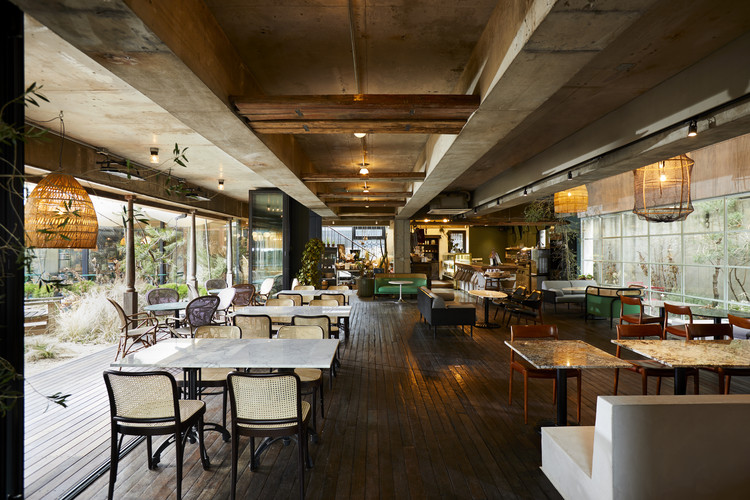Park Hill Hawkins Brown with Studio Egret West
2011-10-12 00:00
架构师提供的文本描述。公园山庄的再生是开发商城市飞溅,谢菲尔德市议会,伟大的地方住房集团,英国遗产和房屋和社区署与建筑师霍金斯\布朗和工作室白鹭西部和景观建筑师格兰特联合。最初的计划,包括一个32英亩的地产上的995套公寓,从1957-61年开始,由杰克·林恩和伊沃·史密斯与谢菲尔德公司城市建筑师ʼ‘s部门的J·L·沃默斯利合作设计。它于1961年6月16日正式开幕。
Text description provided by the architects. The regeneration of the Park Hill estate is a collaboration between developers Urban Splash, Sheffield City Council, Great Places Housing Group, English Heritage and the Homes and Communities Agency with architects Hawkins\Brown and Studio Egret West and landscape architects Grant Associates. The original scheme, comprising 995 flats on a 32-acre estate, dates from 1957-61 and was designed by Jack Lynn and Ivor Smith working with J. L. Womersley of Sheffield Corporation City Architectʼs Department. It officially opened 16 June 1961.
这座建筑在ʼ的四个街区之一揭幕了四套展示公寓,以此庆祝其成立50周年。翻修后的大楼在较低层有75个住宅单元和商业单元。公园山建于市中心东面陡峭的斜坡上(1/10),可以俯瞰整个城市的全景。建筑物轮廓利用现场的地形,保持一个恒定的屋顶水平。这些街区的高度从四层到十三层不等。
The building celebrates its 50th anniversary with the unveiling of the four show apartments in one of the siteʼs four blocks. The refurbished block houses 75 residential flats and commercial units at the lower levels of the building. Built on a steeply sloping site (gradient 1 in 10) to the East of the city centre, Park Hill commands panoramic views of the city. The building profile harnesses the topography of the site keeping a constant roof level. The height of the blocks range from four to thirteen stories.
这座建筑在历史上很重要,因为它是英国联邦调查局(ʼ)第一批完成的战后贫民窟清理计划之一,也是当时最雄心勃勃的市中心开发项目之一。它开创了现代建筑技术、巨大的空间标准和一体化的地区供暖系统,以及臭名昭著的空中ʻ街道ʼ,目的是在高层发展中再现传统街道的社区精神。
The building is historically important as one of Britainʼs first completed schemes of post-war slum clearance and the most ambitious inner-city development of its time. It pioneered modern building techniques, great space standards, and an integrated district heating system, as well as its infamous ʻstreets in the skyʼ which aimed to recreate the community spirit of traditional streets within a high rise development.
1998年,公园山ʼ获授予二级*上市地位后,其前途获得保障,这使它成为欧洲最大的上市建筑。翻修保留了原有结构的完整性,复式公寓和单层公寓布置在一个刚性网格内,每三层楼有一层通道,在甲板上和下面的单层公寓上提供复式公寓。重新开发利用了原始设计的智慧,最大限度地发挥了它所有最好的品质:
In 1998 Park Hillʼs future was secured when it was granted Grade II* listed status, making it the largest listed structure in Europe. The refurbishment retains the integrity of the original structure with duplex and single level apartments arranged within a rigid grid with access decks on every third floor serving duplexes on and above the deck and single-story flats set below. The redevelopment harnesses the intelligence of the original design, maximizing all of its best qualities:
natural ventilation and district heating system
a private balcony for each flat
公寓的方向,居住空间面向南和西,以最大限度地利用自然阳光和热量,卧室面向北或东
the orientation of the flats, with living spaces facing South and West to maximize natural sunlight and heat, and bedrooms facing North or East
空中的ʻ街道(ʼ),它通过连接高架道和地面来利用场地的地形
external access ʻstreets in the skyʼ which utilise the topography of the site by connecting elevated walkways to ground level
尽管最初的设计很周到,也很复杂,但它的布鲁塔式语言已经使人们的观点两极分化,当这个遗产在1980年代失修时,它的声誉就被玷污了。对它的批评者来说,它代表了二战以来英国社会住房的问题。为了使它作为一个重建的社区和重建的地方获得成功,公园山的形象需要改变。虽然建筑物的形式、聚集和结构保持相对不变,但对立面处理的更新引发了建筑物ʼ改造所需的有形影响,以挑战建筑ʼ的社会污名。通过与英国遗产和谢菲尔德市议会ʼ规划部的不断对话与合作,进行了以下建筑干预:
Despite the thoughtfulness and complexity of the original design, its Brutalist language has polarized opinion and when the estate fell into disrepair in the 1980s its reputation was tarnished. To its detractors, it represents what went wrong with Social Housing in Britain since the Second World War. For it to succeed as a re-made Community and a re-made Place the image of Park Hill needed to change. Whilst the form, massing and structure of the building remains relatively unchanged a refresh of the elevation treatment elicits the tangible impact of the buildingʼs transformation needed to challenge the buildingʼs social stigma. Through ongoing dialogue and collaboration with English Heritage and Sheffield City Councilʼs Planning Department, the following architectural interventions have been made:
立面上的砖已被颜色大胆的阳极氧化铝板所取代,这种材料比原来的色调砖更有光泽和反光性,在整个开发过程中在街道的带状上提供了更大的反差。
the brick work in the elevation has been replaced with boldly colored anodized aluminium panels, a material which is more radiant and reflective, providing greater contrast in the banding of the streets throughout the development than the original tonal brickwork
混凝土栏杆已被一种更细长、更高质量的饰面设计所取代。
the concrete balustrades have been replaced with a more slender design cast with a higher quality finish
通过将固空比反演为2/3、1/3固体,开辟了北向和东向高程。这给以前黑暗的卧室空间提供了更多的日光。
the North and East facing elevations have been opened up by inverting the solid to void ratio to 2/3 glazing, 1/3 solid. This gives previously dark bedroom spaces much more daylight.
这些公寓的占地面积增加了,在通往天空街道的门槛处增加了新的存储空间。
the footprint of the flats have increased to incorporate new storage space at the threshold to the Streets in the Sky
看到ʻStreetʼ的走廊和落地窗被引入公寓,以改善对天空中街道的被动监视(最初的建筑师伊沃·史密斯称这是最初设计中最令人遗憾的失败之一)。
hallway and landing windows looking onto the ʻstreetʼ have been introduced into the apartments as a means of improving the passive surveillance of the Streets in the Sky (which the original architect Ivor Smith described as one of the most regrettable failures of the original design).
新的四层楼穿过西北街区,创造了一个欢迎市民的新入口处。
a new 4-story Cut through the Northwest block creates a welcoming and civic scaled new entrance to the estate
an external mirror-finished stainless steel helical stair and glazed external lift core on the West façade of the
西北街区提供了戏剧性的垂直循环,提供了城市全景景观,同时也标志着新的城市入口,原始地产的不透水性和对公共领域缺乏远见是公园山未能发挥作用的根本原因之一。原来的建筑简陋地坐落在风景中。重建的目标是使公园山成为一个特别的地方、一个适当的地方和一个本身的目的地。原计划的失败之一是在地面分配住宅单位,这证明在产生活动和透明度方面存在问题,而且缺乏对公共领域的定义。在翻新计划中,第一阶段的地面(从1.5层上升到3层)完全用于商业、零售、酒吧和餐馆的使用。它的标志是一种不同的标高语言,用清水玻璃将其与住宅单元区分开来,以确保建筑物底部的透明度。剪裁位于这个商业设施中心的中心,标志着公园山村的一个新入口。
Northwest block provides dramatic vertical circulation affording panoramic views of the City whilst marking the new civic entrance. The impermeability of the original estate and lack of vision for the public realm is one of the fundamental reasons why Park Hill didnʼt work. The original building sat crudely in the landscape. The vision for the redevelopment revolves around making Park Hill a special Place, a proper Place and a destination in its own right. One of the failures of the original scheme was the allocation of residential units at ground level, which proved problematic in generating activity and transparency along with a lack of definition of the public realm. In the refurbished scheme the ground level of the first phase (which rises from 1.5 to three stories) is devoted entirely to commercial, retail, bar and restaurant uses. It is marked by a different elevation language of clear flush glazing to demarcate it from the residential units, ensuring a sense of transparency at the base of the building. The Cut is positioned at the centre of this hub of commercial facilities, marking a new entrance to the Park Hill estate.
新的硬软景观露台和土质形式为修复后的建筑物提供了一个高贵而有尊严的环境,让居民、使用者和游客有机会欣赏壮观的景色及其与邻近公园的亲密关系。
New hard and soft landscaped terraces and earth forms negotiate the levels across the site providing a noble and dignified setting for the restored building, offering an opportunity for the residents, users and visitors of the building to enjoy the spectacular view and its intimate relationship to the adjacent park.
Text provided by Hawkins Brown with Studio Egret West
 举报
举报
别默默的看了,快登录帮我评论一下吧!:)
注册
登录
更多评论
相关文章
-

描边风设计中,最容易犯的8种问题分析
2018年走过了四分之一,LOGO设计趋势也清晰了LOGO设计
-

描边风设计中,最容易犯的8种问题分析
2018年走过了四分之一,LOGO设计趋势也清晰了LOGO设计
-

描边风设计中,最容易犯的8种问题分析
2018年走过了四分之一,LOGO设计趋势也清晰了LOGO设计






























































